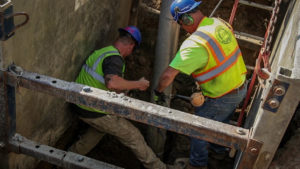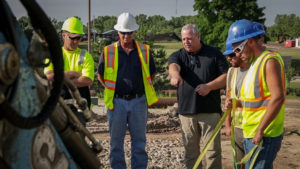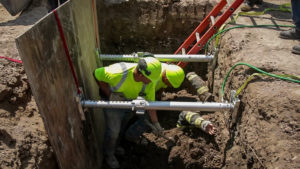Having spent 30-years in emergency services, I can tell you that First Responders are a dedicated, close-knit group of individuals who pride themselves on being able to handle just about anything they encounter. I can also state with certainty that the day they get dispatched to a trench cave-in, they’ll probably be out-gunned.
Most firefighters will go their entire career without ever experiencing this type of call. As a result, it’s quite difficult to justify the purchase of trench rescue equipment. What’s typical, however, is to request mutual-aid from neighboring departments to assist them with the incident.
The fire service, recognizing the need for specialty training has formed special response teams. Departments contribute members and go in on joint purchases to acquire the necessary equipment. So, when the call goes out, they respond. But where are they coming from and how long will it take for them to get there? Keep in mind, not all of these individuals will be on duty, they’ll need to be recalled. Awaiting their arrival will seem like it’s taking forever. Fellow workers will be agitated with what appears to be “in-action” of those already on the scene. But the workers don’t know what the firefighters know… most of those killed in trench cave-ins are would-be rescuers. These include fellow workers, police officers and firefighters; anyone who jumps in to attempt a rescue falls into this category.
Trenches are dynamic, they’re in constant movement. Every trench is going to collapse, it’s a fact. As soon as the wound is placed in the ground [by the backhoe], it wants to heal itself, it wants to reach a state-of-equilibrium, it does this by collapsing. OSHA fatality reports are filled with those who thought they could predict this. Of those killed, most were from a secondary cave-in. Out of compassion and emotion, they jump in eagerly…turning a blind-eye to the hazards. Firefighters now know this and are taught to resist this temptation and never enter an unshored trench.
So, let’s put this in perspective…you’re the victim here. Imagine you’re buried up to your waist and you now know that those who are responding, initially anyways, are trained to not come get you. You’re told to sit tight while everyone waits for some specially trained firefighters to get there; and oh, by the way, we don’t know how long that will take. You also know now that there’s a good chance you could die from a secondary cave-in. Are you kidding me? Unfortunate as it seems, these are the facts.
What I haven’t gone into yet is that, these “specially trained” firefighters don’t get to train very often. Personal obligations and departmental budget constraints limit the amount of time that is spent training. If they’re lucky, they might participate in a trench training exercise two, maybe three times per year. So, with this being the case, how good do you think they could possibly be at this?
Is there a solution? I think there is and it’s staring most of us right in the face. Most municipalities have a resource in town that is on duty Monday thru Friday. They’re available in a moment’s notice and get this, they’re comfortable working in trenches. They have backhoes, trench shoring, trench boxes and vacuum excavators; they use them daily. Who am I talking about?
Public Works! They have the equipment and the know-how; why not capitalize on this.
After 30 years of training municipal public works departments around the country, Prospan has seen an increase in the interest from these departments to get involved. They view this as “it could happen to them one day”. In Illinois, Wisconsin and Indiana, we’ve conducted several trench rescue scenarios where public works personnel got to experience firsthand what it’s like. They were charged with developing the rescue game plan; they did the shoring and the digging, and they retrieved the manikin victim(s). Each participant commented on how it has opened their eyes to the hidden dangers.
So, my suggestion for the fire service is to open its eyes. Consider joining forces with municipal public works departments. We need to train together and learn from one another, and we need to incorporate them into our response effort. Yes, we still need special teams. We still need the incident command system; there’s no one better at it this than the fire service. But let’s not turn a blind eye to resources that are outside our comfort zone. The best players should be in the game, not riding the bench.


